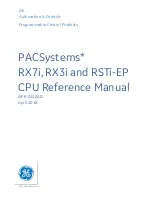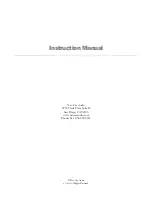
All product and company names mentioned herein
are the trademarks or registered trademarks of their
respective
owners.
*Fixed at neutral if a servo is connected to a port other than a usable transmitter channel.
*The telemetry and Extra Voltage ports cannot be used with the FASST system.
FASSTest ⇔ FASST (Normal-Hi-speed)Change method
1
.
Turn on the receiver.
(
Transmitter OFF
)
2
.
Press and hold the Link/Mode button for at least 5 seconds.
3
.
When the link LED begins to blink green/red the button may be released.
4
.
The link LED should now be blinking red in one of the patterns described by the
chart below. ( Default : FASSTest )
5
.
Each press of the Mode/Link button advances the receiver to the next mode.
6
.
When you reach the mode that you wish to operate in, press and hold the Mode/
Link button for more than 2 seconds.
7
.
Once locked into the correct mode the link LED will change to a solid color.
8
.
Please cycle the receiver(s) power off and back on again after changing the
Channel Mode.
Link LED Red blink
System
1 time
FASSTest
22 time
FASST Multi-ch Normal mode
3
time
FASST Multi-ch High-speed mode
S.BUS ⇔ DG2 (SB/DG2 port)Change method
1
.
Turn on the receiver.
(
Transmitter OFF
)
2
.
Press and hold the Link/Mode button for at least 15 seconds.
3
.
When the link LED begins to blink red the button may be released.
4
.
The link LED should now be blinking red in one of the patterns described by the
chart below. ( Default : S.BUS )
5
.
Each press of the Mode/Link button advances the receiver to the next mode.
6
.
When you reach the mode that you wish to operate in, press and hold the Mode/
Link button for more than 2 seconds.
7
.
Once locked into the correct mode the link LED will change to a solid color.
8
.
Please cycle the receiver(s) power off and back on again after changing the
Channel Mode.
Link LED Red blink
System
1 time
S.BUS
22 time
DG2
FASST
est
FASSTest
FASSTest
is a bidirectional communication system between the
R7114SB
receiver and
FASSTest
capable transmitters. Multiple optional telemetry sensors
may be connected to the
S.BUS2
on the receiver and that data is in turn displayed on the transmitter.
*Please see your transmitter's operation manual to configure transmitter to operate with telemetry sensors.
Link to the transmitter : FASSTest
1
Bring the transmitter and the receiver close to each other, within 20 inches (half
meter).
2
Turn on the transmitter. Place the transmitter into the receiver linking mode.
3
Turn on the receiver.
4
The receiver will wait for the linking process to begin for 2 seconds. Following
that it will return to the normal operation mode.
5
When the link LED of the receiver changes from blinking red to solid green,
linking is complete. (A link waiting state is ended in 1 second.)
• Refer to the transmitter's operation manual for complete details on how to place the
transmitter into the linking mode.
• If there are many FASSTest systems turned on in close proximity, your receiver might have
difficulty establishing a link to your transmitter. This is a rare occurrence. However, should
another FASSTest transmitter/receiver be linking at the same time, your receiver could link
to the wrong transmitter. This is very dangerous if you do not notice this situation. In order
to avoid the problem,we strongly recommend you to double check whether your receiver is
really under control by your transmitter.
• If the System Type of the transmitter is changed, the receiver will need to be re-linked to the
transmitter
.
S.BUS2
S.BUS2
extends
S.BUS
and supports bidirectional communication. Sensors
are connected to the
S.BUS2
port.
*Only S.BUS2 capable devices may be connected to the S.BUS2 port. Standard S.BUS servos
and gyros should not be connected to the S.BUS2 port.
Extra Voltage Telemetry port
It connects with the battery for power, etc.
An optional external voltage input cable (CA-RVIN-700) is used. The
voltage of the battery can be displayed with a transmitter.
When a telemetry adapter (TMA-1) is used : FASSTest only
When using a
TMA-1
(sold separately), change the settings by the following
method.
The
TMA-1
is a device for viewing the telemetry data on a smartphone or
tablet.
R7114SB and TMA-1 linking method
1
.
Switch the receiver to FASSTest system.
2
.
Link the transmitter and receiver, and after confirming operation, turn off the
power.
3
.
Turn on the receiver power. (Transmitter power off)
4
.
Press the Link/Mode switch for at least 10 seconds.
5
.
When the link LED begins to blink green the button may be released.
6
.
The receiver enters the linked with TMA-1 mode, and the LED
simultaneously begins to rapidly blink red and green.
7
.
Press the TMA-1 link switch until the LED starts to blink and wait for the
TMA-1 to link.
8
.
When TMA-1 linking is complete, the TMA-1 LED changes from red to green
for a moment.
9
.
When linking is complete, turn on the receiver power and check the
operation of all the devices.
Link to the transmitter : FASST
1
Bring the transmitter and the receiver close to each other, within 20 inches (half
meter).
2
Turn on the transmitter and receiver.
3
Link operation is performed by the Link/Mode switch.
• When using TM-8 module, it's possible to set F/S position (only 3CH).
0 to 1 sec.
1 to 2 sec.
More than 2 sec.
0 sec.
1 sec.
2 sec.
Press and Hold time
No function
With
TM-8
(not included in this set)
To set the F/S
position(No re-link)
Re-link(ID set) and to
set the F/S position
No function
Besides
TM-8
Re-link(ID set)
*Refer to the instruction manual of the transmitter or module used for a description of the
linking operation, F/S position setting methods and other details.
When using Multi prop (MPDX-1)
The
MPDX-1
can be used with
FASSTest
by merely setting the corresponding
transmitter. (Refer to the instruction manual of the corresponding transmitter.) When
using the
MPDX-1
Multi Prop Decoder (sold separately) with the
FASST
system,
change the setting by the following method. Enable the
MPDX-1
at channels 11 and
12. (Initial value: OFF) Channels 11 and 12 cannot be used individually for
MPDX-
Multi prop mode Change method
1
.
Switch the receiver to the FASST system (Normal or High-speed).
2
.
Turn on the receiver power. (Transmitter power off)
3
.
Press the Link/Mode switch for at least 10 seconds.
4
.
When the link LED begins to blink green the button may be released.
5
.
The receiver enters the multi prop mode and the LED of the current mode
blinks. (Initial value: OFF)
6
.
Each time the switch is pressed, the mode changes.
7
.
When the receiver was switched to the desired mode, press the Link/Mode
switch for at least 2 seconds.
8
.
When the link LED begins to rapidly blink red and green, mode switching is
complete. Release the switch.
9
.
When switching is complete, turn on the power. When the power is turned
on, the receiver switches to the new mode.
FASST
When switched, the
R7114SB
can use the
FASST-Multi-ch
mode. When the
FASST
system is used, the telemetry and Extra Voltage ports cannot be used. The
FASST
system has a Normal mode and a High-speed mode. However, in the High-speed mode, analog servos cannot be used at CH1
-
6.
Link LED Green blink
Mode
Mode
1 time
Multi prop mode OFF
Multi prop mode OFF
2 time
Multi prop mode ON
Multi prop mode ON
FASST
1
output.The
MPDX-1
extends 1 channel to 8 channels. However, since the response
speed becomes slower and there are functional restrictions, use it at simple switch
operation and other applications that require numerous channels.
FUTABA CORPORATION
Hobby Radio Control Business Center Sales & Marketing Department
1080 Yabutsuka, Chosei-mura, Chisei-gun, Chiba-ken, 299-4395, Japan TEL: +81-475-32-6051, FAX: +81-475-32-2915 ©FUTABA CORPORATION 2020, 9 (1)




















